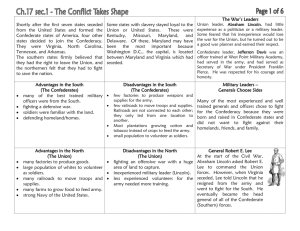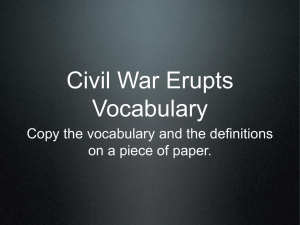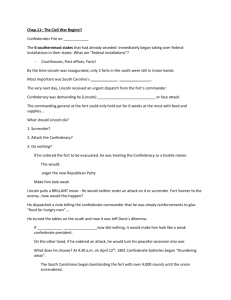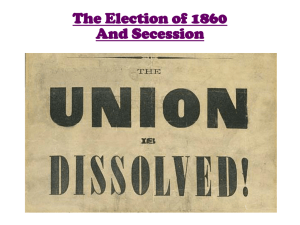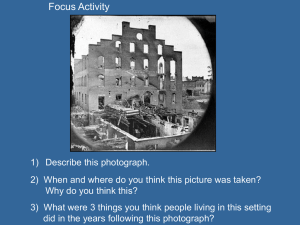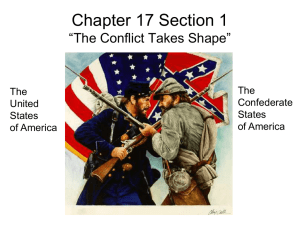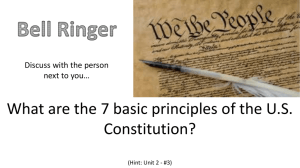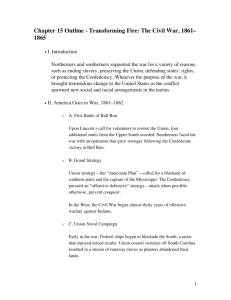AP - C15 Notes _2 - Gatesville High School
advertisement
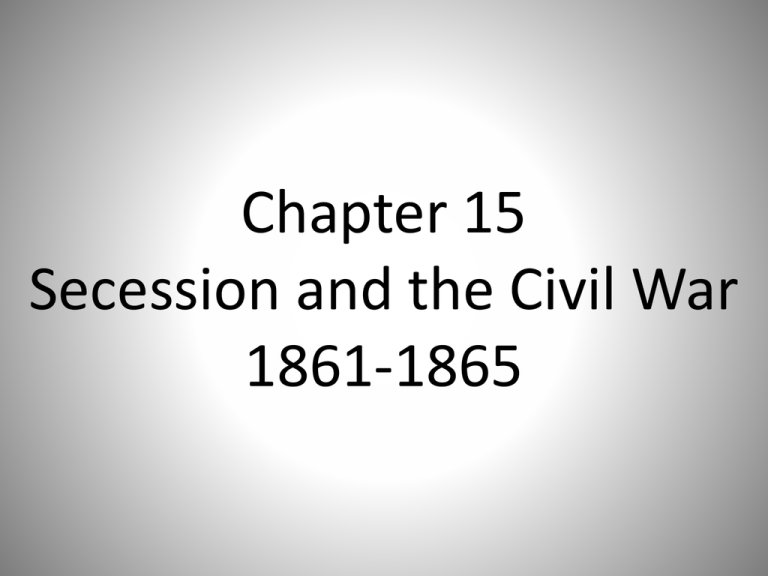
Chapter 15 Secession and the Civil War 1861-1865 How could the US function as a country if its members could come and go as they pleased? The War Starts – Fort Sumter in Charleston, South Carolina • if Lincoln did not resupply the fort, it would have to be abandoned, acknowledging the authority of the Confederate government – Lincoln – told the governor he was sending food, but no soldiers or arms – Davis – ordered General P.G.T. Beauregard to demand the Fort surrender or take it by force; opened fire for a 34-hour bombardment • by firing on federal property, the Confederates had committed an act of open rebellion and Lincoln had no choice but to respond – division between North and South would not be settled peacefully Adjusting to Total War • “total war” – involving every aspect of society – a test of societies, economies, and political systems – a battle of wits between generals and military strategists • North – could achieve its aim of restoring the Union only by defeating the South – would end up being a long war • the Confederacy put up “a hell of a fight” Prospects, Plans, and Expectations • North had an enormous edge in population, industrial capacity, and railroad mileage – had to invade and conquer the South • South had some advantages – Confederacy needed only to defend its territory successfully – faced a less serious supply problem – could choose the time and place of combat • take advantage of familiar terrain and a friendly civilian population – southern leaders defined their cause as defense of their homeland against an alien invader • appealed to the patriotism of a white population • was widely assumed that Southerners would make better fighting men than Yankees – farm boys used to riding and shooting • most of the large proportion of highranking officers in the U.S. Army were of southern origin – resigned to accept Confederate commands • Southerners confidently expected that their armies would be better led • believed major foreign powers such as England and France would come to the aid of the South – their industrial economies depended on southern cotton • both sides tried to find the best way to capitalize on their advantages and compensate for their limitations • Confederate military – stay on the defensive or seek a sudden and dramatic victory by invading the North – chose a mainly defensive war • primary strategic orientation was defensive, an “offensive defense” • Northern military planners had greater difficulty – optimists believed the war could be won quickly and easily by sending an army to capture the capital at Richmond • “On to Richmond” solution died on the battlefields – clear that difficult terrain and an ably led, hard-fighting Confederate army blocked the way • aged General Winfield Scott – commanded the Union army during the early months of the war – recommended an “anaconda policy” – great boa constrictor that would squeeze the South into submission by blockading the southern coasts, seizing control of the Mississippi, and cutting off supplies of food and other necessary commodities • the West became the main focus of military operations • Lincoln decided on a two-front war – keep the pressure on Virginia – authorize an advance down the Mississippi Valley – aim to isolate Texas, Arkansas, and Louisiana – importance on the coastal blockade and expected naval operations to seize the ports through which goods entered and left the Confederacy • plan of applying pressure and probing for weaknesses at several points simultaneously • took maximum advantage of the North’s superiority in manpower and matériel – required better military leadership Mobilizing the Home Fronts • both sides had problems in trying to create the vast support systems needed by armies in the field • both had more volunteers than could be armed and outfitted – recruiting was done primarily by states, who were reluctant to surrender control of the forces they had raised • a short and easy war wasn’t going to happen and the pool of volunteers began to dry up – early recruits had been enrolled for short terms and were reluctant to re-enlist • Confederacy passed a conscription law – Union edged toward a draft as well • materials of war relied mainly on private industry – North – contracted with private firms and individuals to supply the army • there was a lot of corruption and inefficiency – shoddy uniforms that disintegrated in a heavy rain, defective rifles, and broken-down horses unfit for service – by 1863 – factories and farms were producing more than enough to provision the troops without significantly lowering the living standards of northern civilians • because of the South’s weakness of their industrial base, they depended on the outside world for most of their manufactured goods – as the Union blockade became more effective had to rely increasingly on a governmentsponsored crash program to produce war materials • built its own munitions plants • Confederate Ordnance Bureau – headed by General Josiah Gorgas, succeeded in procuring sufficient armaments to keep southern armies well supplied throughout the conflict • Southern agriculture failed to meet the challenge though – planters were reluctant to shift from staples that could not be exported to foodstuffs the were needed • inadequacy of the South’s internal transportation system – limited rail network – most new lines were aimed at the movement of troops rather than the distribution of food • well armed, Confederate soldiers were increasingly undernourished – civilians were rioting to protest shortages of food • Confederate commissary resorted to the impressment of available agricultural produce well below the market value – policy eventually had to be abandoned • question of how to finance an enormously costly struggle – special war taxes • neither side was willing to resort to the heavy taxation that was needed – more willing to die for their government than pay for it • floating loans and bonds • both sides deliberately inflated the currency by printing large quantities of paper money that could not be redeemed in gold and silver – runaway inflation was the inevitable result • was less severe in the North because of the strength of its economy • Confederacy faced a severe shortage of readily disposable wealth – land and cotton could not easily be turned into rifles and cannons – southern treasury had to accept payments “in kind” – Confederate “assets” eventually consisted of bales of cotton that were unexportable because of the blockade • rate of inflation soared – took a wheelbarrow full of money to buy a purse full of goods Political Leadership: Northern Success and Southern Failure • how much democracy and individual freedom could be permitted when military success required an unprecedented exercise of government authority • both constitutions made the president commander in chief of the army and navy • Lincoln was especially bold in assuming new executive powers – expanded the regular army and advanced public money to private individuals without authorization by Congress – declared martial law – enabled the military to arrest civilians suspected of aiding the enemy • suspended the writ of habeas corpus – felt it was necessary because of mob attacks on Union troops passing through Baltimore – enabled the government to arrest Confederate sympathizers and hold them without trial – extended this authority to all parts of the U.S. where “disloyal” elements were active – willingness to interfere with civil liberties was unprecedented and possibly unconstitutional – Lincoln viewed it as a “necessity” to justify a flexible interpretation of his war powers • the Lincoln administration showed restraint and tolerated a broad spectrum of political dissent – government closed down a few newspapers for brief periods – anti-administration journals were allowed to criticize the president and his party – some were arrested for pro-Confederate activity – “Peace Democrats” – called for restoration of the Union by negotiation rather than force • showed the persistence of vigorous two-party competition in the North • Lincoln was adept at the art of party leadership and was able to accommodate various factions and define party issues and principles in a way that would encourage unity and dedication to the cause – held the party together by persuasion, patronage, and flexible policymaking • Jefferson Davis – was a less effective war leader – defined his powers as commander in chief narrowly and literally – assumed personal direction of the armed forces – left policymaking for the mobilization and control of the civilian population primarily to the Confederate Congress • lack of initiative and leadership in dealing with the problems of the home front • devoted little attention to a deteriorating economic situation that caused great hardship and sapped Confederate morale • more serious problem of internal division and disloyalty • refrained from declaring martial law – applied only in limited areas and for short periods Jefferson Davis Inauguration • Davis’s political and popular support eroded – opposed and obstructed by state governors • resisted conscription and other Confederate policies that violated the tradition of states rights • did not have an organized party behind him, and the Confederacy never developed a two-party system – difficult to mobilize the support required for hard decisions and controversial policies North vs. South Advantages • twice as much railroad – made movement of troops, food, and supplies quicker and easier • twice as many factories – better able to produce guns, ammunition, shoes, etc. for army • • • • • economy balanced between farming and industry more money functioning experienced government small army and navy already in place two-thirds of population – 22 million to 9 million – more men available • • • • sufficient labor force to stay behind for farm and factory work more natural resources very urban 23 states Advantages • military colleges in South • majority of nation’s trained officers from South • best military officers – Robert E. Lee • did not need to initiate military action – maintain defensive position and not be beaten • fighting to preserve way of life, and right to self-government – convinced they were right • fighting for home • trading relationship with Europe – British and French sympathies • long coastline difficult to blockade • 11 states North vs. South Disadvantages • not into the war • not in complete agreement over the abolition of slavery • lost most good military officers Disadvantages • small navy • long coastline hard to defend • southern slaves, although a large part of the population were not any help – 3.5 million • little industry and factory production • very rural – Union Military Strategies • General Winfield Scott - naval blockade, choke off the Confederacy; gain control of Mississippi and cut Confederacy in two • Anaconda Plan – after a type of snake that coils around its victims and crushes them to death – Confederate War Strategies • prepare and wait • war of attrition – one side inflicts continuous loses on the enemy in order to wear down its strength – Tactics and Technology • bullet-shaped ammunition – drifted less than a round ball (older type) • rifling – spiral groove cut on the inside of a gun barrel, makes bullet pick up spin, so it goes faster and straighter (500 yards, not 100 – muskets) – reloaded and fired faster than muskets • shells – devices that exploded in the air or when they hit something • canister – special type of shell filled with bullets
